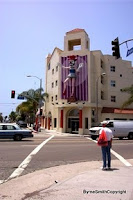 |
| An Acrylic of Mine on Canvas from 2008 |
I don’t think anyone would disagree that his paintings are eye-catching, even now, and can you imagine their reception and impact in the late 19th century (think Victorian era)? Naked native ladies were in many of his motifs in case you don’t get my drift.
While I don’t particularly (or maybe that should be personally) care for his style--who am I to judge--what I really admire is his bold use of color as a main element in most of his work.
One of the things I got out of the article that sticks with me is that Gauguin did not even become a full-time painter until he was in his mid-30s when he switched from being an accountant, of all things--can you get more unrelated to art? However, he had painted prior to that and with some success. (That should give hope to the rest of us even if we're not accountants.)
Of course, he’s probably most notoriously remembered for his altercation with van Gogh in Arles just before van Gogh mutilated his (own) ear, whatever that was about.
Then there was Tahiti and all the paintings that came from his life there in the 1890s. There’s a great illustrated time-line in the article highlighting the high and interesting points in his life
Anyway, I thank Ms. Morrison and Smithsonian for publishing an informative article with insight that makes me want to learn even more details about Gauguin and his painting life.
Happy Painting!




